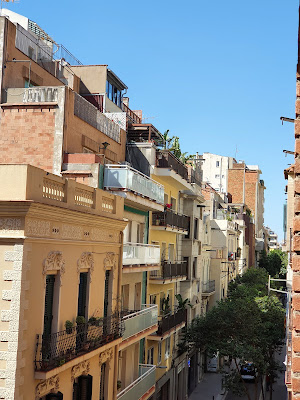They're here! - the first two books in my Canary Isles trilogy: Hera's Orchard and Bitter Oranges.
As I told you in a previous post, these novels have had a long and chequered past. I first wrote the story - or something like it - many years ago, when I spent two winters with my husband, artist Alan Lees, living in the Canaries. Alan was skippering a charter yacht, a big, beautiful catamaran called Simba.
The first year, I lived aboard the boat and helped take care of our customers. I also got pregnant. By the time we came back the following winter, it was with our six week old son. We borrowed an apartment in Los Cristianos from a friend, while Alan worked, and I spent several blissful months looking after Charlie in a child-friendly place. My parents and then Alan's mum flew down to help.
But our real love was La Gomera. It was where we had taken our visitors. It was where we went for sweet, clean water for the boat And it was a place we explored ourselves, loving everything about it. It was also where I wrote the first drafts of this story, which would become a radio play and an unsatisfactory novel that was published so badly that my then editor later wrote to me to apologise for the violence they had done to my subtle story of a cross cultural relationship.
I filed it away under bitter experience, but then, decades later, with my own imprint (Dyrock Publishing) as well as a good many traditionally published books under my belt, I thought I would try again. My two main characters - Luis and Margaret - just wouldn't sit down and shut up. I loved them far too much to let them go.
A couple of years ago, I published the first part, under the title Orange Blossoms, but quite soon, took it down again, because I still wasn't very happy with it. If you look for the new version, Hera's Orchard, you'll find its previous title in the book description. I did quite a bit of rewriting and editing, although if you are one of the few people who bought and read Orange Blossoms, don't worry. If you want to know what happens next, you can pick up exactly where you left off, and find out what becomes of the marriage, in Bitter Oranges.
You can also download a freebie of the eBook of Hera's Orchard from 9th - 13th April, so if you want to check out the new version, you'll be able to do that as well.
Bitter Oranges is the sequel and you'll find it as an eBook or a paperback.
I knew what I didn't want to do. I didn't want to write about a 'holiday romance gone wrong' or a scammer, or an untrustworthy foreigner, or all the other tropes that seem to crop up again and again in UK fiction and drama. I wanted to write a genuine love story, but more than that, I wanted to write a love story about two people from very different backgrounds. Luis says 'soy un buen hombre' and so he is. Let's face it - love and marriage can be challenging enough, even for good men and women, if they come from very different cultures. If they speak different languages. Languages that perhaps shape their thoughts differently.
Brexit added yet another horrible layer of complexity and potential trouble, one I certainly didn't foresee when I was writing that first radio play, but one which I had to tackle head on in these new books.
Does it work out? What do you think?
 |
| Both these lovely covers images are by my talented husband. |








.jpg)















